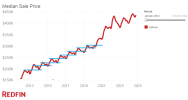TerryRohrer
Elite Member
- Joined
- Aug 13, 2005
- Professional Status
- Certified General Appraiser
- State
- Montana
Note that a refinance is now a sale. Wonder if the price is appraised value? Mortgage amount?
The FHFA HPI is a broad measure of the movement of single-family house prices. The FHFA HPI is a weighted, repeat-sales index, meaning that it measures average price changes in repeat sales or refinancings on the same properties. This information is obtained by reviewing repeat mortgage transactions on single-family properties whose mortgages have been purchased or securitized by Fannie Mae or Freddie Mac since January 1975.

 www.fhfa.gov
www.fhfa.gov
What does the FHFA HPI represent?
The FHFA HPI is a broad measure of the movement of single-family house prices. The FHFA HPI is a weighted, repeat-sales index, meaning that it measures average price changes in repeat sales or refinancings on the same properties. This information is obtained by reviewing repeat mortgage transactions on single-family properties whose mortgages have been purchased or securitized by Fannie Mae or Freddie Mac since January 1975.

FHFA House Price Index® | FHFA
The FHFA House Price Index® (FHFA HPI®) is a comprehensive collection of publicly available house price indexes that measure changes in single-family home values based on data that extend back to the mid-1970s from all 50 states and over 400 American cities.

